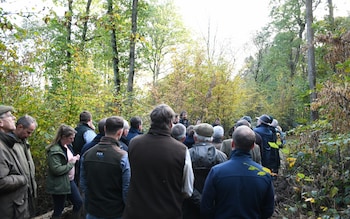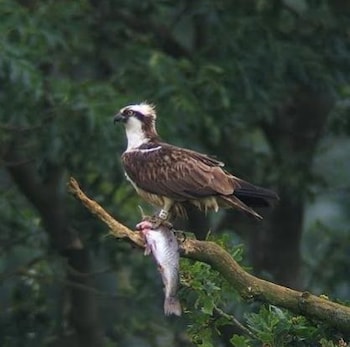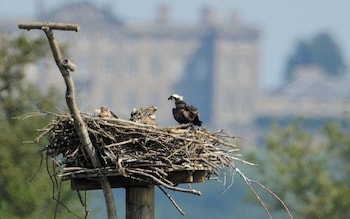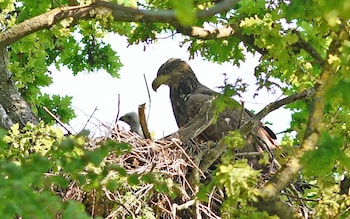
White Stork Project at Knepp estate is one of several successful bird recovery programmes in the UK
If you look up to the skies of Sussex,you might be lucky enough to catch sight of something that hasn’t been seen for more than 600 years: a stork,fledged from a nearby nest. With their enormous wingspan,it’s hard to mistake them for anything else and the last time they were resident in England was just a year after the Battle of Agincourt.
Amid fears of biodiversity loss and climate change,their return is a rare piece of good news. Thanks,though,to the hard work of the RSPB,dedicated conservation groups,collaborative farmers and thousands of volunteers,there are growing numbers of certain species of birds in Britain,some brought back from near extinction,others have been reintroduced after an absence of hundreds of years.
“Generally,things aren’t doing well,there’s a perpetual decline for many birds,” admits Jon Carter of the British Trust for Ornithology (BTO),“but there are key species that are turning a corner or bucking this trend.”

Collaboration: Farmers meeting to learn about nightingales
The last recorded breeding pair of storks in Britain was in 1416,having died out due to a combination of human interference in their habitats,but also,explains Laura Vaughan-Hirsch,a white stork officer at Knepp,because they were aggressively hunted. “They appear as dishes on medieval menus,” she says. Apparently they were boiled then roasted and put on display at banquets.

White storks bred in Britain for the first time in 600 years at Knepp
In order to reintroduce them,the project copied methods that had already been successful across Europe. “One of the things we identified is that you have to get a population that’s not migratory to act as a magnet,” says Laura. To do this,they used Polish storks that had been injured after flying into electricity pylons or caught in traffic collisions. “It’s a nice bit to the story – a bird that could never fly and would never survive in the wild becomes a vital part of reintroduction.”
These birds were brought over in 2016,but there was no breeding until 2020 when four chicks fledged off Knepp. “This year we’ve ringed 34 so far and we’re hoping for another 10 or so. When colonies get going they tick up quite rapidly,but migratory birds have high mortality rates,so the colony is still in development.”
Laura believes that the symbol of storks as bringers of new life means that they are particularly useful to conservationists. “People of all ages can recognise a stork without a camera or binoculars – they’re a large charismatic thing that gets them thinking about big nature and landscape recovery.”
Their work is heavily reliant on the 40 volunteers attached to the project who do everything from supplementary feeding the non-flying birds to digging ditches. “I love that we’ve got a massive range of ages from students to volunteers in their 80s. We have a guy who runs a camera trap programme capturing thousands of images that allows us to say,‘That’s a stork that I know was in France last week.’”
“In Mesolithic Britain there were about 2,000 pairs,” explains George Smith,the information officer at the project,“and that only changed because of human persecution,as they were considered a threat to the fishing industry.” What the project seeks to do,in other words,is to restore their numbers to these natural levels. “Natural spread from the Scottish ospreys down to the English nest sites would take hundreds of years to naturally reoccur,” he says,“so it was decided that we’d nudge it along to reinstigate the population.”

Catch of the day: An osprey at the Leicestershire and Rutland Wildlife Trust with its prey
Once the original pairs were translocated from Scotland in 1996,there was a period of hopeful waiting,given that migration makes it difficult to predict how many will return to nest. “The hope was that we’d release them,they’d head off on migration and two years later – which is how long it takes to reach true adulthood – we would see the birds again.”
It’s the males that return to site,while the females can end up anywhere in a bid to guarantee genetic diversity. In 1999,the first of the males came back. Then in 2000,one of the males finally nested with a female and the first osprey chicks to fledge from an English nest since the 1800s.

Ospreys nesting in Rutland Water - the previous Pandion haliaetus seen in the UK was spotted in the nineteenth century
Credit: David Tipling
“We’ve dubbed him Mr Rutland as so many juveniles are related to him,” says George. He’s joined in superstar osprey status by Maya,who’s been breeding for 15 years. “One of the nicest things every year is to see Maya back on the nest and to know that the season is starting.”
As at Knepp,the Rutland volunteers are key,especially in connecting with the public. “They are our frontline of engagement with the public… it’s such a treat to see people who had no interest become enthralled by how outstanding ospreys are and learning their story.”
His work to reintroduce white-tailed eagles,colloquially known as sea eagles,after being persecuted to extinction,began back in 1968,when four were reared and released on Fair Isle. A 10-year project to establish them on the Isle of Rùm followed. “But then I decided we would go to the south of England,” he recalls,“because there’s far more food – fish,rabbits,geese.”

Landmark: A white-tailed eagle chick,pictured in 2023 with one of its parents,was the first to fledge in southern England for 240 years
Credit: Roy Dennis Wildlife Foundation/Forestry England
He faced various battles along the way,including Covid and the restrictions brought on by avian flu,but was aided by a partnership with Forestry England and Natural England,as well as,he believes,a document signed off by Michael Gove,environment minister at the time. “We probably wouldn’t have got permission from any of the subsequent ministers,” he says. “With all these things you have to just go,don’t hang around.”
The first six birds were released in August 2019 and soon caused excitement. “It’s a massive bird with a two-and-a-half-metre wingspan,“and people during Covid would see this massive bird flying over and they’d say ‘I never thought I’d see such a huge bird flying around our skies and it gives me hope that we can restore nature in our country’.”
Now there are four pairs on the Isle of Wight and one on Poole Harbour,with the hope that almost all of them will be breeding this year.
© OfficialAffairs